The Kia EV9 electric SUV is inching towards its production debut. Its imminent reveal is prefaced by two teaser videos released by Kia, showing off the silhouette and the production-spec lighting.
This is a big e-SUV – dwarfing even the Kia Sorento and on a par with the US-market Telluride. Expect prices to be similarly ambitious, stretching to £60k and beyond (depending on spec) as the Koreans target the likes of the new seven-seat Volvo EX90 and Tesla Model X.
Happily, the videos show that the exterior design has barely changed from the days of the concept car, with animated lighting at the front and a properly boxy silhouette. We suspect the interior will not be as dramatic as the concept car, however.
Hasn’t Kia already shown its EV9?
Not in full, no. Kia released its own ‘spy’ pictures of the production version of its new EV9 all-electric SUV earlier in 2022, as it progresses through its testing regime (below). The new seven-seater is coming to market in the second half of 2023, ahead of a formal debut very soon.
The Korean brand is on a roll at present, going from making good-value-if-plain cars to properly desirable ones like the Stinger GT and EV6 – one of our favourite electric cars right now.
Its new EV9 sets to continue that upward trend. Given it’s a seven-seat SUV, it’ll sit above the EV6 in Kia’s electric line-up and, because it’ll be based on a stretched version of the EV6’s e-GMP underpinnings, it’ll have the same 800-volt electrical system. That means superfast charging speeds – the EV6, for example, can charge from empty to 80 percent in just 18 minutes.
Kia hasn’t yet told us how far the EV9 will be able to travel on a single charge but, to be competitive in the market, it’ll need a maximum range of around 300 miles. That would put it well ahead of the 260-mile Mercedes EQB, but behind the 348-mile Tesla Model X.
This isn’t an unreasonable goal, though. Kia’s engineers have an extra 300mm of space to use between the EV9’s axles, which means there’s plenty of room for a bigger battery. Kia’s also keen for the new EV9 to be a proper off-roader rather than a soft SUV, as part of its testing trials see it being thrashed on the rough stuff.

Clever stuff. What else do we know about the 2023 Kia EV9?
Quite a lot, but most of it is marketing fluff linked to the striking EV9 Concept (below). For example, the brand’s design team told us that the EV9 Concept’s styling is ‘inspired by water.’ No, we couldn’t figure that one out either. Normally, when water is this solid and blocky, it’s bobbing around the Arctic Ocean with a family of polar bears riding on it.
Apparently, the EV9 is all about ‘serenity, calmness and wellbeing,’ as well as being one with the planet. And while all of that might sound like an extract from the hippie handbook, there’s some genuinely clever sustainable engineering underneath the EV9’s surface.
The concept’s flooring is made from recycled fishing nets, the seat upholstery is made from recycled plastic and the ‘leather’ you see in the cabin didn’t come from a cow. It’s a vegan alternative that kicks off Kia’s plans to gradually reduce the use of animal leather in its vehicles.
Kia also says that the Concept’s cabin has a trio of modes that can transform the car’s seating layout to suit the situation. The first, called Active, makes the cabin look like your average car, with all the seats facing forward. It’s used when the car is being driven.
The second two settings can only be activated when the car is parked up. Pause mode rotates the front seats to face the rear, and the middle row of seats fold into a table, which Kia says makes the interior feel more like a ‘first class lounge.’
The third setting is called Enjoy mode. It rotates all of the seats to face the rear of the vehicle and opens the tailgate, which Kia says gives ‘all occupants the opportunity to connect with the outside environment and gaze ahead and beyond the vehicle while sitting comfortably.’ Nice idea, but we’re not sure why that couldn’t be done looking out of the windscreen.
Whether any of these modes will make it to the production version is a different story. A stolen glimpse inside a prototype at the Nurburgring rather suggests a much plainer, more conventional interior is planned…
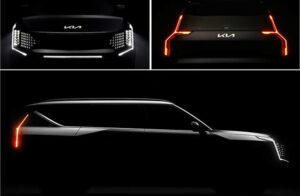
Any fancy technology to report on the EV9 concept car?
Plenty. The dashboard features an ultra-wide 27-inch display, which has a series of menus to control the car’s climate controls and media functions. The various menus can be navigated using touch-sensitive buttons on the dashboard.
Kia has also updated its ‘Tiger Nose’ grille for the electric era, swapping its grille vents for a solid body-coloured panel with pixel-art style daytime running lights. However, when the car is switched off, those pixels become invisible – and the grille just looks like a normal panel.
See that massive vent in the bonnet, too? Well, it’s not a vent – it’s actually a solar panel that Kia says can trickle charge the car’s battery pack. Naturally, the amount of electricity it can harvest is small because of its size, but every little helps.
Bear in mind that everything mentioned so far relates to the concept, so some of it (such as the revolving seats) will be excluded on the production model for reasons of cost, practicality and safety. However, there’s a good chance those sustainability ideas will come good.
Full design unveil coming March 15th! Can’t wait!!!
source: car mag




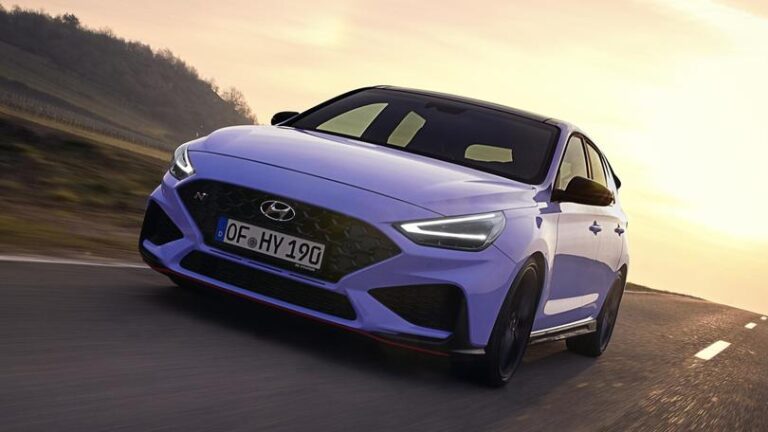
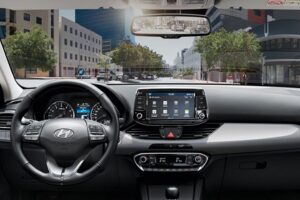
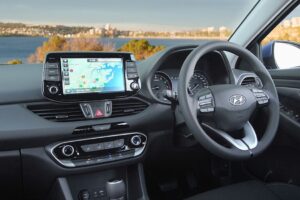


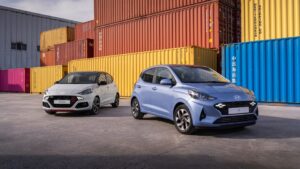 Sportier than before but still compact, the i10 is no Ioniq 5 or Ioniq 6, but it now better resembles its larger and i20 and i30 siblings. Nine colours are available – that’s two more than before – and the headlamps have been tweaked too: the DRL’s have been nicely blended into the i10’s honeycomb grille, making for a neater and more aggressive front-end. The rear of the car also gets a reworked LED signature – as it the norm for cars in the 20s – and it’ll run on 15-inch alloys.
Sportier than before but still compact, the i10 is no Ioniq 5 or Ioniq 6, but it now better resembles its larger and i20 and i30 siblings. Nine colours are available – that’s two more than before – and the headlamps have been tweaked too: the DRL’s have been nicely blended into the i10’s honeycomb grille, making for a neater and more aggressive front-end. The rear of the car also gets a reworked LED signature – as it the norm for cars in the 20s – and it’ll run on 15-inch alloys.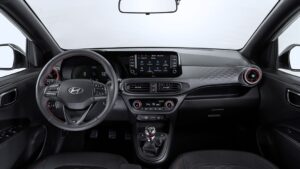 Inside, expect a slightly more of a premium feel. There’s blue ambient lighting for the front passengers, GTI style-tartan on the seats as an option and additional purple highlights around the vents and on stitching.
Inside, expect a slightly more of a premium feel. There’s blue ambient lighting for the front passengers, GTI style-tartan on the seats as an option and additional purple highlights around the vents and on stitching.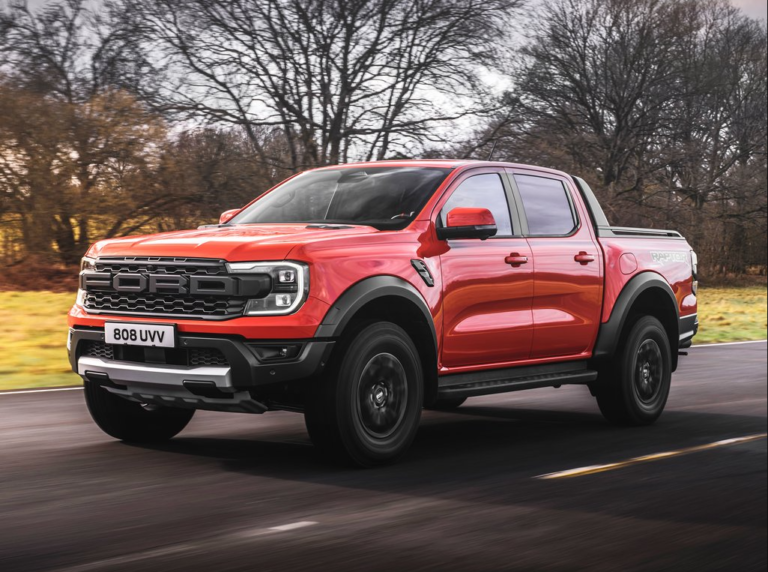
 The 2023 Ford Ranger Raptor is basically a downsized version of the high-flying, velocity-defying F-150 Raptor. As with its big brother, the off-road-ready Ranger will also feature flared fenders, rugged tires, extra ground clearance, and an unmistakable grille. While it will ride on the same fully boxed ladder frame as the regular Ranger, the Raptor variant will receive a long-travel suspension for soaring over jumps and a more powerful engine for quicker desert runs. The Ford will only be offered in one body style—a crew cab connected to a five-foot cargo box. The interior should have distinct flourishes and a feature-laden infotainment system.
The 2023 Ford Ranger Raptor is basically a downsized version of the high-flying, velocity-defying F-150 Raptor. As with its big brother, the off-road-ready Ranger will also feature flared fenders, rugged tires, extra ground clearance, and an unmistakable grille. While it will ride on the same fully boxed ladder frame as the regular Ranger, the Raptor variant will receive a long-travel suspension for soaring over jumps and a more powerful engine for quicker desert runs. The Ford will only be offered in one body style—a crew cab connected to a five-foot cargo box. The interior should have distinct flourishes and a feature-laden infotainment system. The 2023 Ranger Raptor will feature a twin-turbocharged 3.0-liter V-6 that’s said to make 392 horsepower and 430 pound-feet of torque. However, those figures could be slightly different than the U.S. version. It’s essentially the same setup found on the Ford Bronco Raptor, which includes a 10-speed automatic transmission and standard four-wheel drive, complete with locking front and rear differentials. Compared to its pedestrian counterpart, the Raptor will have a sturdier suspension and beefier off-road equipment. Along with a higher ride height and increased ground clearance, it has 33-inch all-terrain tires that bookend wider front and rear tracks.
The 2023 Ranger Raptor will feature a twin-turbocharged 3.0-liter V-6 that’s said to make 392 horsepower and 430 pound-feet of torque. However, those figures could be slightly different than the U.S. version. It’s essentially the same setup found on the Ford Bronco Raptor, which includes a 10-speed automatic transmission and standard four-wheel drive, complete with locking front and rear differentials. Compared to its pedestrian counterpart, the Raptor will have a sturdier suspension and beefier off-road equipment. Along with a higher ride height and increased ground clearance, it has 33-inch all-terrain tires that bookend wider front and rear tracks.
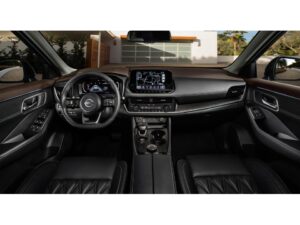 The 2023 Nissan Rogue is almost as big as the Honda CR-V, and the interior room is similar. In fact, the Nissan boasts a headroom advantage when not equipped with a sunroof, but that setup is only available on the lower two trims.
The 2023 Nissan Rogue is almost as big as the Honda CR-V, and the interior room is similar. In fact, the Nissan boasts a headroom advantage when not equipped with a sunroof, but that setup is only available on the lower two trims.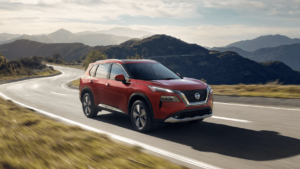 As this is the top trim, the 2023 Nissan Rogue Platinum features all the available bells and whistles. They include a standard 9.0-inch infotainment touchscreen, which is an inch bigger than the one offered in other trims, and a 12.3-inch cluster display instead of analog gauges. Apple CarPlay and Android Auto are easy to set up and load quickly, and second-row riders get USB charge points, heated seats, temperature controls, and their own LCD temperature readout. ProPilot Assist hands-on semi-autonomous driving technology is also standard on three out of four models.
As this is the top trim, the 2023 Nissan Rogue Platinum features all the available bells and whistles. They include a standard 9.0-inch infotainment touchscreen, which is an inch bigger than the one offered in other trims, and a 12.3-inch cluster display instead of analog gauges. Apple CarPlay and Android Auto are easy to set up and load quickly, and second-row riders get USB charge points, heated seats, temperature controls, and their own LCD temperature readout. ProPilot Assist hands-on semi-autonomous driving technology is also standard on three out of four models.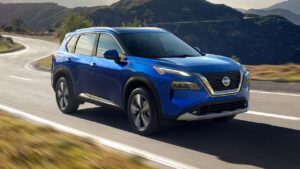 The 2023 Nissan Rogue Platinum is an excellent all-arounder suitable for most shoppers in the compact SUV segment. With its new powertrain, the Rogue is more efficient without a quickness penalty, and we appreciate how practical and upscale its two-tone cabin has become. This isn’t an SUV created to deliver athletic dynamics or off-road capability, but it finally stands as a compelling alternative to the strong offerings from Honda and Toyota.
The 2023 Nissan Rogue Platinum is an excellent all-arounder suitable for most shoppers in the compact SUV segment. With its new powertrain, the Rogue is more efficient without a quickness penalty, and we appreciate how practical and upscale its two-tone cabin has become. This isn’t an SUV created to deliver athletic dynamics or off-road capability, but it finally stands as a compelling alternative to the strong offerings from Honda and Toyota.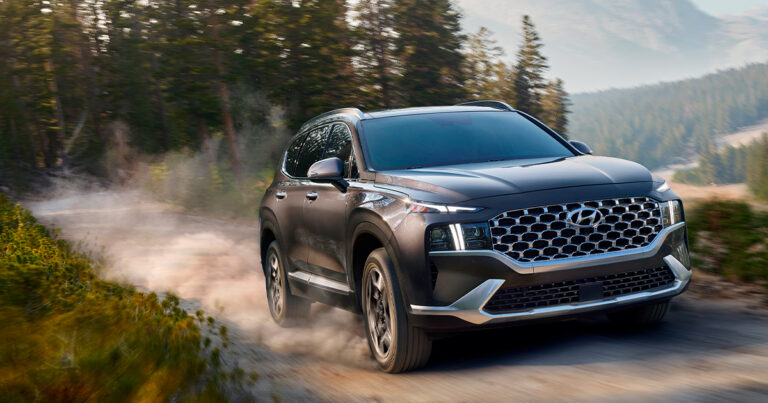
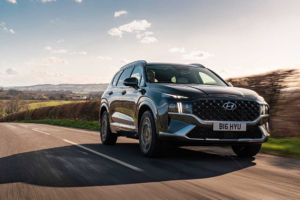 We’ve tested these other variants of the Santa Fe, and because we are closet Hyundai statisticians, we were curious how they’d compare. First, acceleration: The Santa Fe PHEV made it from 0 to 60 mph in 7.0 seconds and took the quarter mile down in 15.2 seconds at 93.1 mph. That made it significantly quicker than the regular hybrid, which we timed at 8.2 seconds to 60 and 16.2 in the quarter, but not as fleet of tire as the 2.5T, which made 60 in 6.2 and ran the quarter in 14.6. T. The Santa Fe’s ability, like other Hyundai/Kia hybrids, to deliver power smoothly and evenly across the rev range is quite impressive.
We’ve tested these other variants of the Santa Fe, and because we are closet Hyundai statisticians, we were curious how they’d compare. First, acceleration: The Santa Fe PHEV made it from 0 to 60 mph in 7.0 seconds and took the quarter mile down in 15.2 seconds at 93.1 mph. That made it significantly quicker than the regular hybrid, which we timed at 8.2 seconds to 60 and 16.2 in the quarter, but not as fleet of tire as the 2.5T, which made 60 in 6.2 and ran the quarter in 14.6. T. The Santa Fe’s ability, like other Hyundai/Kia hybrids, to deliver power smoothly and evenly across the rev range is quite impressive.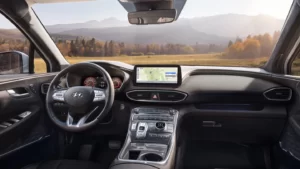 No surprises, then: The second-most-powerful Santa Fe is also the second-quickest, with handling that provided a few unexpected smiles. So along with its generous interior and commutable all-electric range—enough that many drivers may need scarcely any gasoline at all—the Santa Fe delivers good performance for a vehicle in its class.
No surprises, then: The second-most-powerful Santa Fe is also the second-quickest, with handling that provided a few unexpected smiles. So along with its generous interior and commutable all-electric range—enough that many drivers may need scarcely any gasoline at all—the Santa Fe delivers good performance for a vehicle in its class.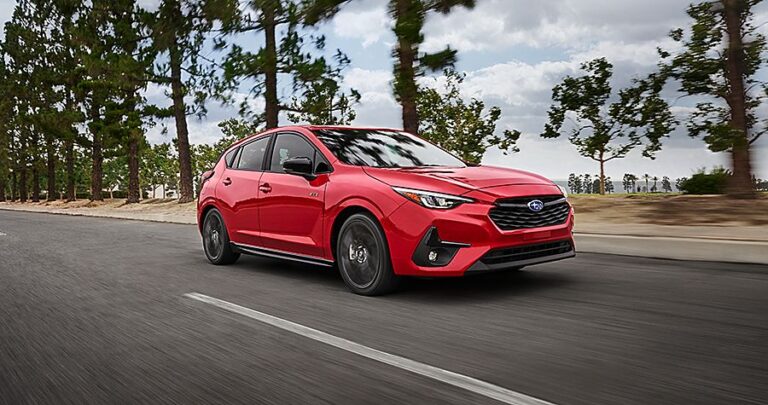
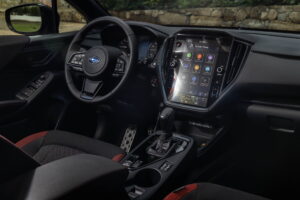 A healthy dose of extra standard equipment helps soften the sticker shock, as even the base model now has automatic climate control, LED headlights, and an upgraded set of driver-assistance features, which Subaru brands as EyeSight. The 2024 Impreza Sport starts at $26,085, which is slightly cheaper than last year’s Impreza Sport hatch. It adds 18-inch wheels, different suspension tuning, a larger 11.6-inch vertically oriented touchscreen, pushbutton start, and fog lights.
A healthy dose of extra standard equipment helps soften the sticker shock, as even the base model now has automatic climate control, LED headlights, and an upgraded set of driver-assistance features, which Subaru brands as EyeSight. The 2024 Impreza Sport starts at $26,085, which is slightly cheaper than last year’s Impreza Sport hatch. It adds 18-inch wheels, different suspension tuning, a larger 11.6-inch vertically oriented touchscreen, pushbutton start, and fog lights.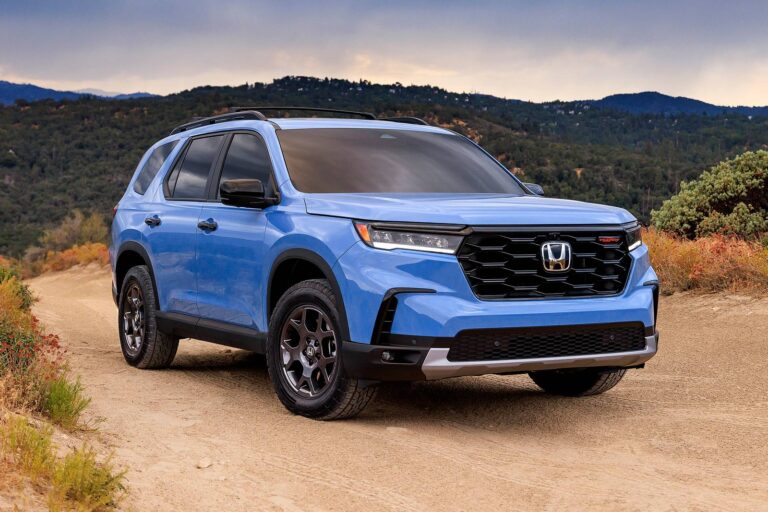
 Let’s talk exterior: The robust, new front end of the Pilot houses a hexagon-mesh grille and narrow-eyed LED highlights, creating a dominant impression. Whether you’re loading or unloading, a short kick under the bumper is all that’s needed for the available hands-free access power tailgate to open to the rear cargo space. To lock up when you’re done, simply press the Walk Away Close button on the Touring and Elite trims and walk away. The tailgate will close, and every door—as well as the tailgate—will lock,
Let’s talk exterior: The robust, new front end of the Pilot houses a hexagon-mesh grille and narrow-eyed LED highlights, creating a dominant impression. Whether you’re loading or unloading, a short kick under the bumper is all that’s needed for the available hands-free access power tailgate to open to the rear cargo space. To lock up when you’re done, simply press the Walk Away Close button on the Touring and Elite trims and walk away. The tailgate will close, and every door—as well as the tailgate—will lock,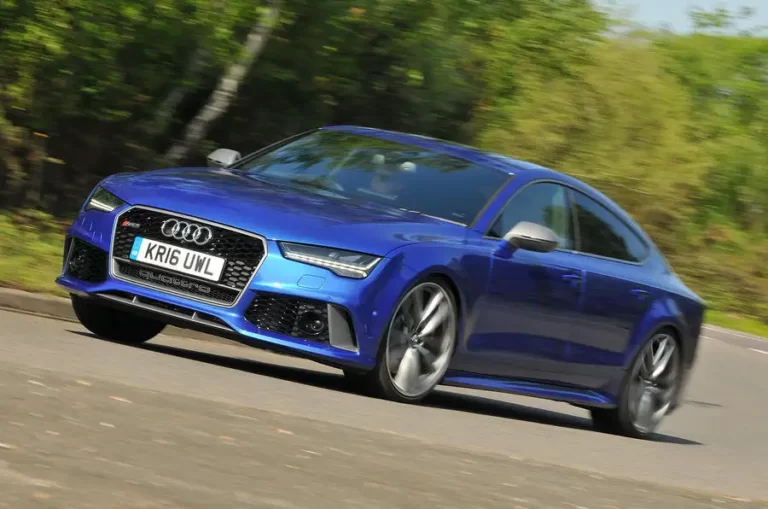
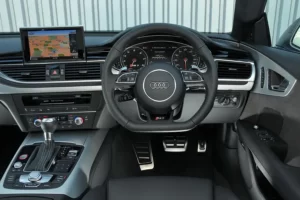 And it’s not like a swooping body really impairs practicality: the RS7 still has enough room for the family and, with a hatchback tailgate, a boot that’s big enough to swallow most of their clutter.
And it’s not like a swooping body really impairs practicality: the RS7 still has enough room for the family and, with a hatchback tailgate, a boot that’s big enough to swallow most of their clutter. “The RS7 is the RS6 Avant’s less shouty non-identical twin. It’s just as talented but slightly more svelte in appearance and reserved in taste. If you’re after more for your money or can’t quite stretch to your perfect RS6, the RS7 is a great alternative involving little compromise. It offers bombastic performance, a good record for quality and 90% of a brand-new one for less than 50% of the cost. Consumables may be expensive, but for the money there are few finer or faster ways to consume super unleaded.”
“The RS7 is the RS6 Avant’s less shouty non-identical twin. It’s just as talented but slightly more svelte in appearance and reserved in taste. If you’re after more for your money or can’t quite stretch to your perfect RS6, the RS7 is a great alternative involving little compromise. It offers bombastic performance, a good record for quality and 90% of a brand-new one for less than 50% of the cost. Consumables may be expensive, but for the money there are few finer or faster ways to consume super unleaded.”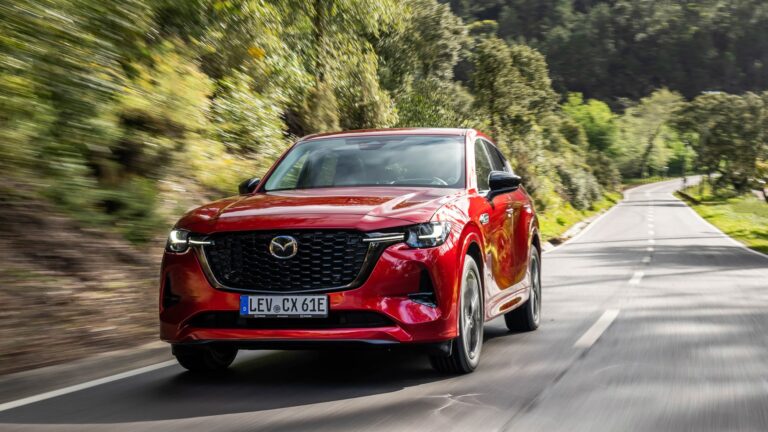
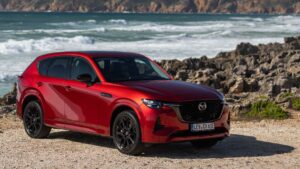 Unusual as the engineering is, the CX-60 looks subtle. It’s imposing with an on-trend oversized grille, but beyond that, it’s similar to a CX-5 – itself a looker – but with an interesting cab-back stance that marks it out as a rear-wheel focused engineering package. The flanks are nicely sculpted, but if you choose it in neutralising silver, that’s lost and it can look a little bland.
Unusual as the engineering is, the CX-60 looks subtle. It’s imposing with an on-trend oversized grille, but beyond that, it’s similar to a CX-5 – itself a looker – but with an interesting cab-back stance that marks it out as a rear-wheel focused engineering package. The flanks are nicely sculpted, but if you choose it in neutralising silver, that’s lost and it can look a little bland.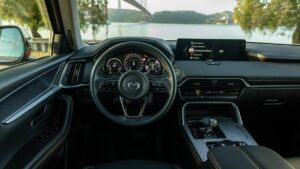 Mazda’s dual-screen dashboard and infotainment is crisp, clear and easy to use, retaining the wheel and buttons on the console and actual, physical heater controls as well. The standard windscreen-projected head up display is colourful and reasonably large, too.
Mazda’s dual-screen dashboard and infotainment is crisp, clear and easy to use, retaining the wheel and buttons on the console and actual, physical heater controls as well. The standard windscreen-projected head up display is colourful and reasonably large, too.